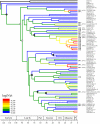Contrasted patterns of hyperdiversification in Mediterranean hotspots
- PMID: 19116275
- PMCID: PMC2629191
- DOI: 10.1073/pnas.0805607106
Contrasted patterns of hyperdiversification in Mediterranean hotspots
Abstract
Dating the Tree of Life has now become central to relating patterns of biodiversity to key processes in Earth history such as plate tectonics and climate change. Regions with a Mediterranean climate have long been noted for their exceptional species richness and high endemism. How and when these biota assembled can only be answered with a good understanding of the sequence of divergence times for each of their components. A critical aspect of dating by using molecular sequence divergence is the incorporation of multiple suitable age constraints. Here, we show that only rigorous phylogenetic analysis of fossil taxa can lead to solid calibration and, in turn, stable age estimates, regardless of which of 3 relaxed clock-dating methods is used. We find that Proteaceae, a model plant group for the Mediterranean hotspots of the Southern Hemisphere with a very rich pollen fossil record, diversified under higher rates in the Cape Floristic Region and Southwest Australia than in any other area of their total distribution. Our results highlight key differences between Mediterranean hotspots and indicate that Southwest Australian biota are the most phylogenetically diverse but include numerous lineages with low diversification rates.
Conflict of interest statement
The authors declare no conflict of interest.
Figures


Similar articles
-
Presence in Mediterranean hotspots and floral symmetry affect speciation and extinction rates in Proteaceae.New Phytol. 2015 Jul;207(2):401-410. doi: 10.1111/nph.13244. Epub 2014 Dec 23. New Phytol. 2015. PMID: 25537140
-
Evolution of a hotspot genus: geographic variation in speciation and extinction rates in Banksia (Proteaceae).BMC Evol Biol. 2013 Aug 19;13:155. doi: 10.1186/1471-2148-13-155. BMC Evol Biol. 2013. PMID: 23957450 Free PMC article.
-
Contrasting patterns of radiation in African and Australian Restionaceae.Evolution. 2003 Dec;57(12):2688-702. doi: 10.1111/j.0014-3820.2003.tb01513.x. Evolution. 2003. PMID: 14761050
-
The radiation of the Cape flora, southern Africa.Biol Rev Camb Philos Soc. 2003 Nov;78(4):597-638. doi: 10.1017/s1464793103006171. Biol Rev Camb Philos Soc. 2003. PMID: 14700393 Review.
-
Biogeography and speciation of terrestrial fauna in the south-western Australian biodiversity hotspot.Biol Rev Camb Philos Soc. 2015 Aug;90(3):762-93. doi: 10.1111/brv.12132. Epub 2014 Aug 15. Biol Rev Camb Philos Soc. 2015. PMID: 25125282 Review.
Cited by
-
Age estimates for the buckwheat family Polygonaceae based on sequence data calibrated by fossils and with a focus on the amphi-Pacific Muehlenbeckia.PLoS One. 2013 Apr 5;8(4):e61261. doi: 10.1371/journal.pone.0061261. Print 2013. PLoS One. 2013. PMID: 23585884 Free PMC article.
-
Phylogenetic analysis of fossil flowers using an angiosperm-wide data set: proof-of-concept and challenges ahead.Am J Bot. 2020 Oct;107(10):1433-1448. doi: 10.1002/ajb2.1538. Epub 2020 Oct 7. Am J Bot. 2020. PMID: 33026116 Free PMC article.
-
Fire-adapted Gondwanan Angiosperm floras evolved in the Cretaceous.BMC Evol Biol. 2012 Nov 22;12:223. doi: 10.1186/1471-2148-12-223. BMC Evol Biol. 2012. PMID: 23171161 Free PMC article.
-
A population genomics analysis of the Aotearoa New Zealand endemic rewarewa tree (Knightia excelsa).NPJ Biodivers. 2024 Mar 20;3(1):7. doi: 10.1038/s44185-024-00038-6. NPJ Biodivers. 2024. PMID: 39242911 Free PMC article.
-
Widespread homogenization of plant communities in the Anthropocene.Nat Commun. 2021 Dec 6;12(1):6983. doi: 10.1038/s41467-021-27186-8. Nat Commun. 2021. PMID: 34873159 Free PMC article.
References
-
- Cowling RM, et al. Plant diversity in Mediterranean-climate regions. Trends Ecol Evol. 1996;11:362–366. - PubMed
-
- Myers N, et al. Biodiversity hotspots for conservation priorities. Nature. 2000;403:853–858. - PubMed
-
- Mittermeier RA, et al. Hotspots Revisited: Earth's Biologically Richest and Most Endangered Terrestrial Ecoregions. Mexico City: CEMEX; 2004.
-
- Cowling RM, Lamont BB. On the nature of Gondwanan species flocks: Diversity of Proteaceae in Mediterranean South-western Australia and South Africa. Aust J Bot. 1998;46:335–355.
-
- Linder HP. The radiation of the Cape flora, southern Africa. Biol Rev. 2003;78:597–638. - PubMed
Publication types
MeSH terms
LinkOut - more resources
Full Text Sources
Molecular Biology Databases

